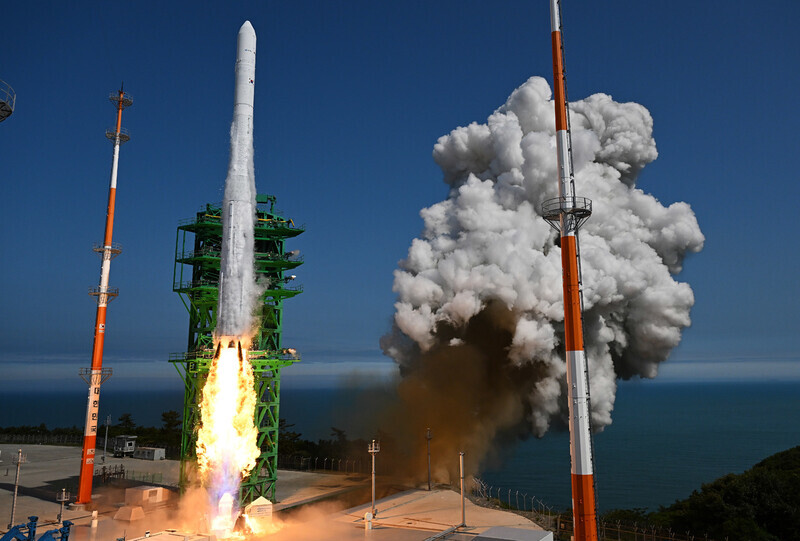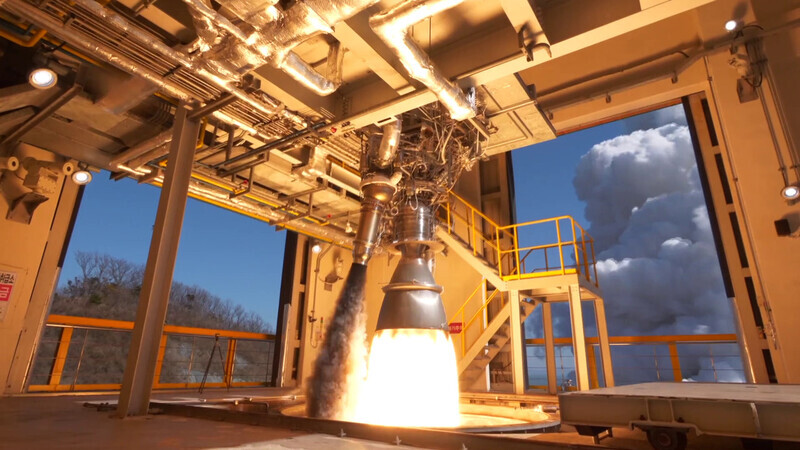hankyoreh
Links to other country sites 다른 나라 사이트 링크
Behind S. Korea’s successful Nuri launch was 30 years of blood, sweat and tears

On June 4, 1993, the Korean Sounding Rocket-I lifted off from the Anheung test facility in Taean County, South Chungcheong Province. With a thrust of 8.8 metric tons and a weight of 150 kilograms, it reached an altitude of 39 kilometers and flew for 101 kilometers.
That day marked the first time that a South Korean-launched rocket traveled through the skies. Twenty-nine years later, this Tuesday, the Nuri rocket soared to an altitude of 700 kilometers and placed a satellite into low-Earth orbit, successfully flying for a distance of over 2,800 kilometers (second stage). Compared with 29 years before, the thrust was 34 times greater (300 tons) and the weight 10 times heavier (1.5 metric tons).
The space development journey leading up to Nuri has been a rocky one.
By 1997, South Korea had produced a second KSR with homegrown technology. But because of the South Korea-US missile guidelines, it long faced limitations making it unable to achieve flight altitudes capable of sending a launch vehicle into space. Those guidelines were dropped last year.
The conditions in South Korea were also unfavorable. The domestic researchers who developed a 30-ton liquid propellant engine in 2003 had no local testing facility available, which meant they had to take their engine to Russia to conduct combustion testing. An explosion in the process resulted in components being incinerated, and Russia’s decision to stop allowing testing visits caused further difficulties in launch vehicle development.

Nuri’s predecessor, the carrier rocket known as Naro, had a similarly troubled journey.
Two months after construction was completed on the Naro Space Center in June 2009, South Korea attempted to launch Naro as a two-stage Korean launch vehicle with a Russian Angara rocket as its first stage, but the launch failed when the fairing failed to separate correctly. A year later in June 2010, a second Naro launch attempt ended in an explosion of the first-stage rocket, dealing another blow to South Korea’s dreams of advancement in space development.
The third Naro launch on Jan. 30, 2013, was successful. Thanks to its perseverance through setbacks, South Korea had finally joined the ranks of countries that had successfully launched rockets into space. But the Naro launch vehicle had not been produced entirely with South Korean technology.
It was in 2010 that the Ministry of Science and ICT and Korea Aerospace Research Institute (KARI) began development on the Nuri. This large-scale project involved investments totaling 1.9572 trillion won through 2023. Based on its experience developing a 30-metric ton engine, KARI began work on developing a 75-metric ton one — but it had no facilities for testing the engine once it was developed.

Around 500 billion won, or roughly a quarter of the total project budget, went into building around 10 engine testing facilities, including a general combustion test building. To date, a total of 34 75-metric ton engines have been produced and tested, along with 12 of the 7-metric ton engines used for Nuri’s third stage.
The 75-metric ton engines have collectively undergone 18,290 seconds of combustion testing in 184 different tests, while the 7-ton engines have undergone 16,925 seconds of testing in 93 tests.
“While there was an engine explosion midway through, fortunately, no one was hurt,” said Ko Jeong-hwan, director of KARI’s Korean space rocket development directorate.
KARI researchers were responsible for the entire process behind the Korean launch vehicle from development to launch. They had no set rules, people, or textbooks to tell them how many vehicles they would have to develop when making them or what procedures they would have to go through. Even so, they were able to overcome the setbacks with the first Nuri launch failure and succeed at their second attempt eight months later.
By Lee Keun-young, senior staff writer
Please direct questions or comments to [english@hani.co.kr]

Editorial・opinion
![[Column] Season 2 of special prosecutor probe may be coming to Korea soon [Column] Season 2 of special prosecutor probe may be coming to Korea soon](https://flexible.img.hani.co.kr/flexible/normal/500/300/imgdb/original/2024/0426/3317141030699447.jpg) [Column] Season 2 of special prosecutor probe may be coming to Korea soon
[Column] Season 2 of special prosecutor probe may be coming to Korea soon![[Column] Park Geun-hye déjà vu in Yoon Suk-yeol [Column] Park Geun-hye déjà vu in Yoon Suk-yeol](https://flexible.img.hani.co.kr/flexible/normal/500/300/imgdb/original/2024/0424/651713945113788.jpg) [Column] Park Geun-hye déjà vu in Yoon Suk-yeol
[Column] Park Geun-hye déjà vu in Yoon Suk-yeol- [Editorial] New weight of N. Korea’s nuclear threats makes dialogue all the more urgent
- [Guest essay] The real reason Korea’s new right wants to dub Rhee a founding father
- [Column] ‘Choson’: Is it time we start referring to N. Korea in its own terms?
- [Editorial] Japan’s rewriting of history with Korea has gone too far
- [Column] The president’s questionable capacity for dialogue
- [Column] Are chaebol firms just pizza pies for families to divvy up as they please?
- [Column] Has Korea, too, crossed the Rubicon on China?
- [Correspondent’s column] In Japan’s alliance with US, echoes of its past alliances with UK
Most viewed articles
- 1Samsung subcontractor worker commits suicide from work stress
- 2Division commander ordered troops to enter raging flood waters before Marine died, survivor says
- 3No good, very bad game for Korea puts it out of Olympics for first time since 1988
- 4‘We must say no’: Seoul defense chief on Korean, USFK involvement in hypothetical Taiwan crisis
- 5[Column] Season 2 of special prosecutor probe may be coming to Korea soon
- 6Is N. Korea threatening to test nukes in response to possible new US-led sanctions body?
- 7Korea’s 1.3% growth in Q1 signals ‘textbook’ return to growth, says government
- 8US overtakes China as Korea’s top export market, prompting trade sanction jitters
- 9[Column] Has Korea, too, crossed the Rubicon on China?
- 10[Column] ‘Choson’: Is it time we start referring to N. Korea in its own terms?